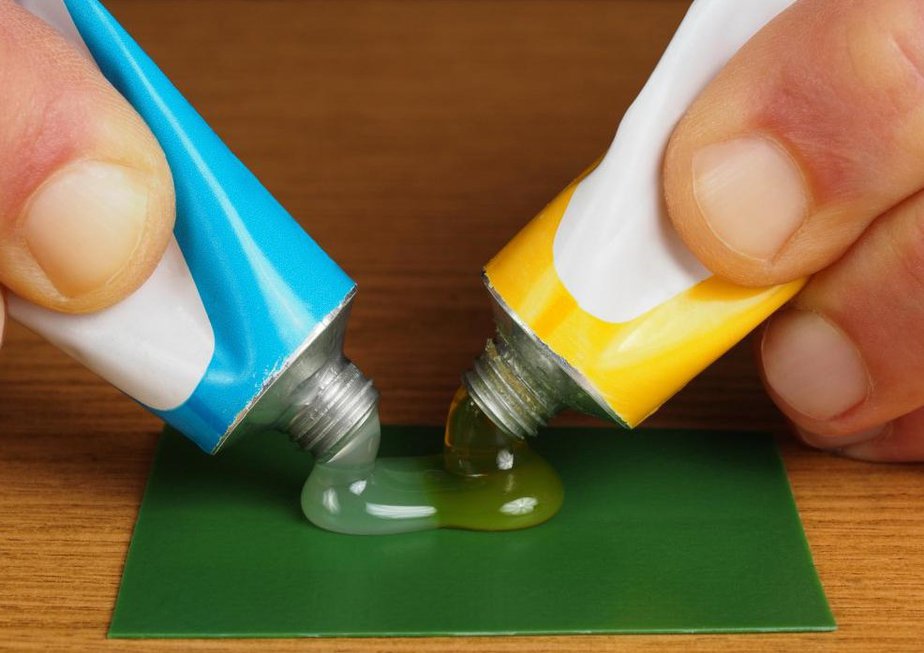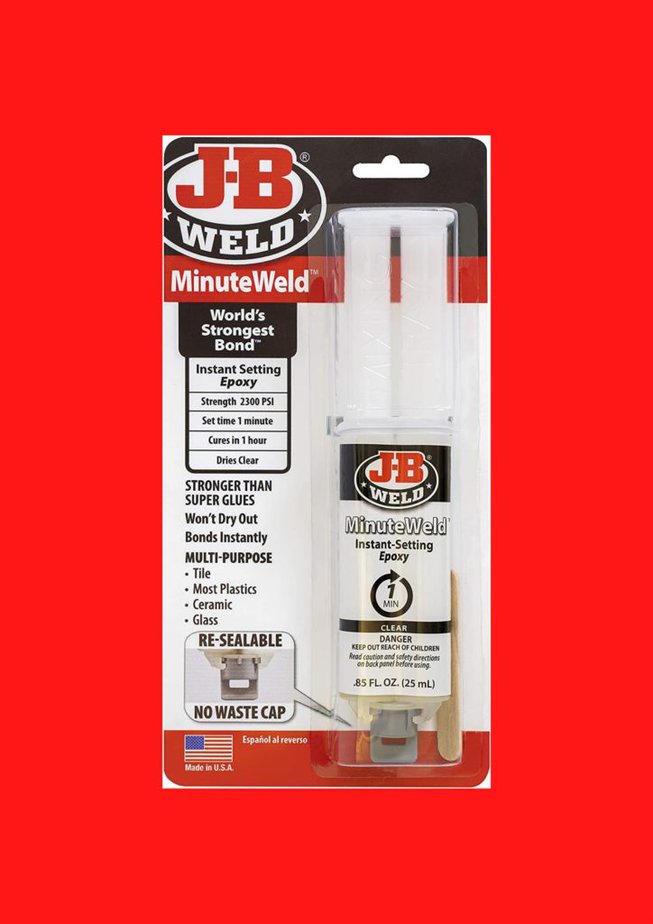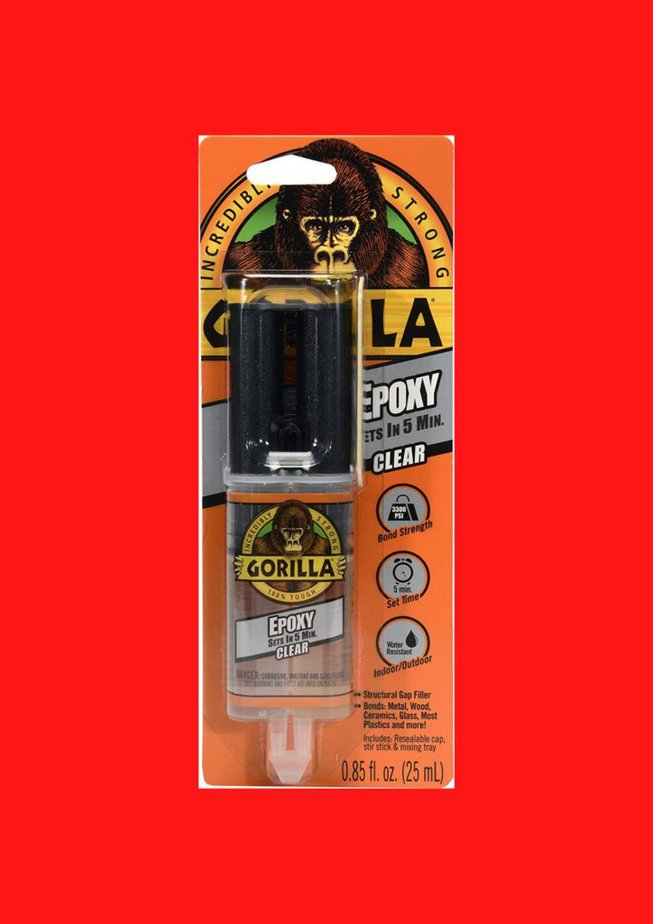Breaking your favorite mug, plate or ornament can feel like a disaster but, thanks to ceramic glue, all is not lost. Putting your favorite ceramic piece back together is not as difficult as you think, and with a good glue in your tool kit, you can be sure that you will save a broken ceramic piece.
Besides the fact that ceramic glue is an excellent tool for fixing broken ceramic products, it can also be used to repair ceramic tiles for floors and countertops. In this article, we will look at the many uses of this glue, how to use it and what to pay attention to when buying this product to make sure that you get the best ceramic glue in your everyday life. We’ll also look at some great brands of ceramic glue that you can add to your toolbox.
This may interest you: Best Metal Glue / Best Glue for Glass or Best Glue for Wood.What is ceramic glue?
As the name suggests, ceramic glue is an adhesive that is strong enough to glue broken ceramic products back together. There are a huge range of ceramic products out there and there are different glues that are better suited to specific products (we go into this in more detail in the next section).
Generally, ceramic glues are exceptionally strong adhesives that are capable of permanently sticking broken ceramic products back together. There are a multitude of uses for ceramic glue including mending broken plates, bowls, mugs as well as fixing precious antiques, souvenirs and also ceramic tile that you may have in your kitchen or bathroom.
Prices are extremely common, but owning a product is a very economical way of repairing broken items rather than replacing them.
Top 10 Best Glue for Ceramic 2023 [Updated]
Now you know the miracles with which ceramic glue can work it’s time to take a look at some excellent products. Here are our pick of the Top Ten Ceramic Glues of 2023.
#1 Best Ceramic Glue for Household Repairs: Gorilla 2 Part Epoxy, 5 Minute Set
Gorilla are a top household name when it comes to manufacturing epoxy glue so what better brand to trust than this for dealing with ceramic breakages.
This number one bestseller is popular for a reason, this glue has excellent strength and will be able to glue almost any ceramic breakage that you have. In addition, this glue is water-resistant, so it can be used to attach household items such as plates and mugs.
With this epoxy glue from Gorilla, you also don’t need to worry about measuring out the resin and the hardener and finding the perfect ratio as the two-point syringe does that for you.
The hardener and the resin are kept separate in the dispenser so that they don’t harden over time, but when it comes to using the glue all you need to do is push the plunger into the resin and the hardener and this will dispense an equal amount of each.
All that is left to do is mix the two together for 20 seconds and then it will be ready to use. This epoxy glue also dries clear so you don’t need to worry about any ugly glue stains.
#2 Best Ceramic Glue for Repairing China: Elmer’s E1012 China and Glass Cement, 1 Ounce
This glue from Elmer’s is specifically designed to repair broken pottery and china so this is the one to go for if you’re finding that your best cups and saucers are looking in need of some TLC. This glue is non-toxic and is super quick to try, setting in just one minute and then it comes to its full strength 3 days later.
What is also great about this best glue for ceramic is that it is water resistant, so ceramics repaired with this glue can still be washed in the dishwasher. With 65 years’ experience under their belt, you can be sure that Elmer’s is a brand that you can trust. This is an excellent glue that is worth having on hand if you ever need to make urgent repairs!
#3 Best White Ceramic Glue: Pratley Adhesives Quickset White Epoxy – Shiny White Finish
This super-strong glue from Pratley Adhesives is actually a multi-purpose glue but is an excellent choice when it comes to repairing ceramics. This shiny white glue will be a great choice if you need to fix some broken white porcelain plates or even fill in the chips in the sink or toilet! This glue is a 2 part epoxy which is easy to use and administer.
The qualities of this glue make it a strong contender thanks to its super adhesive strength, as well as the fact that it is quick to set so no more waiting around. Another great feature which is particularly useful when repairing ceramics is that the dried glue can be filed down so that you can create a really neat finish on your repaired plates or mugs.
What’s more, with this glue in your tool kit, you will also be able to use it on stone, concrete, glass, fiber glass and some metals should you need to!
#4 Best Super Glue for Ceramic Repairs: Loctite Super Glue Gel, 2 Gram Tube (235495)
If you’re looking for a straight forward super glue to mend your ceramics then look no further than this glue gel from Loctite. It comes in an easy to use tube which makes administering the glue incredibly easy (as well as safe) meaning you will have those broken pieces glued back together in no time.
Suitable for use with ceramics, this glue would be a good choice if you need to repair something quickly as it sets within seconds. The dried product is also clear making a tidy and aesthetically pleasing repair. This is a pretty small tube containing 2 grams so will be best used for small ceramic repair jobs. This glue has excellent value for money and will soon turn a disaster into a solvable problem.
#5 Best Super Glue for Small Ceramics: Gorilla 6770002 Micro Precise Super Glue, 5 Grams Clear
If you’ve broken a small ceramic ornament and need a glue that will allow for precision as well as a long-lasting repair then this Micro Precise Super Glue from Gorilla is the one. The design of the dispenser and applicator means that you can have full control as you dispense the glue exactly in the area you need.
This glue dries fast so make sure you are quick to stick the ceramic pieces together once you have applied the glue as it will be dry within 10-45 seconds. The strength of this glue means that no clamping is required.
Plus, this super glue is designed to be impact resistant so can protect your ceramic product from breaking again if another accident was to occur. This is one of the best glue dispensers around that will fit easily in your hand and make that repair a breeze.
#6 Best Ceramic Glue for Hairline Crack: Devcon Epoxy Glue
When you see a hairline fracture emerging in your favorite ceramic mug or other household item it is important to act fast before further damage is done.Fortunately, thanks to excellent adhesives, such as this epoxy glue from Devcon, cracks on the hair can be easily eliminated. This kit contains resin and hardener, which must be combined to produce a high-strength epoxy adhesive.
This epoxy glue is not only suitable for use with ceramics, it can also be used on other materials such as wood, concrete, glass and any bits of broken china that you have in your kitchen. The glue will set in 30 minutes after application and will ensure that the hairline crack in your ceramic item is sealed.
#7 Best High Power Super Glue for Ceramics: Strongest Super Glue by HG Power Glue
This isn’t just any old super glue this is the HG Power Glue which is an incredibly strong and long-lasting cyanoacrylate adhesive. It is highly suitable for use on broken ceramics and has the added benefit of being both water-resistant and heat resistant making it an ideal choice for ceramic items that need to go in the dishwasher or oven/microwave.
This highly effective glue is 600% more effective than regular glue, meaning that it will be an excellent adhesive to stick back together broken ceramic pieces so that they are as good as new. Plus, you can store this super glue for up to 2 years if you keep it in the refrigerator or freezer.
It can also be used on a host of other materials such as plastic, wood, rubber, and metal so is a useful adhesive to have in your tool kit should anything else need repairing.
#8 Best Ceramic Glue Filler: J-B Weld 50101 MinuteWeld Instant-Setting Epoxy Syringe – Clear – 25ml
The great thing about epoxy adhesives is that they can fill in the gaps if you don’t have enough ceramic particles that you want to repair. This epoxy glue from J-B Weld will do just that and comes in a handy syringe dispenser which makes combining the resin and hardener needed to make the epoxy a dream.
Promising to deliver the World’s Strongest Bond you can be confident that your repair job will be a success.
It can be used on most ceramics and is also a good option for broken floor or countertop tiles. The syringe will dispense equal measures of resin and hardener which you need to mix together to create the epoxy glue.
It can then be added to the broken edges of your ceramics to reattach the broken particles, as well as fill in any missing gaps or chips. The glue will set in 60 seconds and takes around one hour to cure completely. This is a great value way of repairing some broken household items.
#9 Best Glue for Repairing Ceramic Tiles: Red Devil 0497 Tile Paste Adhesive Squeeze Tube, White
Ceramic tiles are a beautiful addition to any home but when they crack they are a little less appealing. Fortunately, with the help of good glue, you can repair ceramic floor tiles, ceramic bathroom tiles and ceramic countertop tiles. This tile paste from Red Devil will do just the job and comes in a handy dispenser which means trowelling is not necessary (saving you time and hassle).
In addition to repairing ceramic tile, you can also use this tile paste to create creative mosaics and it can also be used on linoleum. This tile glue takes around 30 minutes to set and it also has a minimal odor which makes for a much more pleasant experience than many adhesives out there.
Once it has dried, this tile glue will remain white so it is important that it is only used with white tiles otherwise the effect may not be what you are after.
#10 Best Waterproof Ceramic Glue: Gorilla Glue Waterproof Polyurethane , 18 ounce bottle, Brown
This glue from Gorilla is a great all-rounder that can repair pretty much anything and is a great choice for ceramics as the glue is waterproof. This heavy-duty and versatile adhesive is an especially good choice if you are repairing something that spends its life outdoors, such as a ceramic plant pot, as this adhesive is designed to withstand the elements and whatever the world decides to throw at it.
It can do this as the glue expands 3 times into the material where it is placed so that it creates an incredibly strong and fixed bond.
Gather your broken pieces of ceramic together and put this glue to action to witness this amazing ceramic glue in action. For best results, Gorilla recommends clamping the pieces you are gluing together and leaving for 1-2 hours for the glue to dry, you will then need to leave it for 24 hours to cure.
This 18 ounce bottle has a shelf life of around a year once opened (if stored in a cool dry place) and can also be used as an adhesive for a range of materials in addition to ceramics so is a handy product to have in your home.
What are the different types of glue ceramic?
There are two main types of ceramic glues: epoxies and super glues. In this next section, we will explain the differences between epoxies and super glues and which type of glue should be used for specific ceramic items.
#1 Epoxies

Epoxy glues are a type of polymer glue which are made of two starting compounds: resin and hardener. Usually, you will mix these two compounds yourself in order to create a very strong glue. The more hardener you use in your mixture the stronger the glue will be, however, it will also take longer to dry so this is a factor worth considering.
A distinctive feature of epoxy glue is that it is 100% waterproof, which means that it is the best glue that can be used if the repaired product needs washing (for example, mugs, plates and other ceramic dishes).The strength of this glue is impressive, so once you have stuck something in place it is certainly there to stay (so make sure you don’t spill any of this accidentally!).
It can be a little tricky to get the ratios right when mixing epoxy glue, however, fortunately, you can purchase the starting compounds already measured out by manufacturers in order to create an effective and long-lasting epoxy glue.
Another downside of using an epoxy glue is that it can be a little more visible than other glues when using it to repair a damaged ceramic product (however, you can purchase different colored epoxy glues to match the ceramic you are mending).At the same time, using this glue, you will find that it is incredibly heat-resistant, withstands high pressure and is waterproof.
The advantage of using glue is that it can also be used as a gap filler, which means that in addition to gluing ceramic parts, it can also fill gaps if the fragments do not fit perfectly together.
#2 Super Glue

Super glues are generally easier to use than epoxies as they do not require you to mix the compounds yourself. They are made out of cyanide-derived cyanoacrylate which hardens as it reacts with the moisture in the air.
If you’re looking for ease of use a super glue is a good option as it can be used directly from the container and they dry quickly once applied. Glue is a handy ceramic glue if you are looking for a quick fix when disaster strikes.
The downside of using super glue is that it is not as strong as epoxy glue, it is also easily dissolved so not a great waterproof option if you’re going to be repairing items that regularly go in the dishwasher. Glue is also unable to fill in gaps, so if you don’t have all of the broken pieces this type of glue will not be able to fill in the voids in the same way that epoxy glue can.
What is best epoxy or super glue for ceramics?
In general, epoxy glue is stronger and more durable than superglue. However, it is also more time-consuming to use and requires mixing the components in the right ratio to create an effective mixture.
Superglue is a good choice if you have all the broken parts and you just need glue to glue them together. As a rule, glue is best used to fix broken ceramic jewelry that does not need to withstand frequent use to put in the dishwasher. For a quick solution to the problem, superglue is a ceramic glue that will solve your problems.
For a longer-lasting solution, and for items that need to be immersed in water, an epoxy glue would be a better option. While it is harder to use than super glue it is capable of filling in the voids if you do not have all of the broken pieces and can resist stress and pressure much more effectively than glue.
To summarise, epoxy glue is the better option to use for ceramics that need to withstand daily use whereas super glue would be a perfectly effective option to repair ceramic ornaments (as long as you have all of the broken pieces!). Glue is also what you need if you want to fix ceramic tiles.
What is the best glue ceramic?: Buying Guide
The type of ceramic glue you purchase will be dependent on what you need to repair with it. All adhesives of good quality should be accompanied by detailed instructions about which ceramic products they can be used with, as well as about the properties of the glue itself. In this buying guide, we go through everything you need to consider when purchasing a ceramic glue.
#1 What you want to use it for
As we’ve already gone through, the ceramic product you want to repair will determine the type of ceramic glue that you buy. Make sure that you check the product description to see if the glue is suitable for your needs.
It is also important to consider the color of the item you are wishing to repair, if it is going to be obvious where the glue has been placed you will want to opt for either a clear ceramic glue or a glue that is the same color as your broken item.
#2 Waterproof
Epoxy glues are generally waterproof whereas super glues are less likely to be water-resistant. If the product you are repairing is going to require washing or to be put in the dishwasher make sure that you check if the ceramic glue you are purchasing is water-resistant. The last thing you want is to painstakingly stick your favorite pot back together only to see if disintegrate at the first sign of water.
#3 Food safe
Another thing to consider when purchasing a ceramic glue to fix an item of dinnerware is whether or not it is food safe. Ceramic glues can be incredibly strong which is often likely to mean they contain chemicals that you may not be wanting to put near to food items.
Look out for the FDA approval stamp on the ceramic glue you’re thinking about purchasing and if you see it you will know that it is safe to repair a ceramic product that you are going to eat off or drink out of.
#4 Shape of the container
It might seem trivial but the type of container the ceramic glue comes in will determine how easy it is to apply this glue to your broken item. Some ceramic glues will come with a helpful nozzle fitted so that you can easily direct the glue to the right place, others come with a brush included so that you have greater control over where the glue goes.
You want to avoid a glue container that results in excess dripping as this will not only waste glue but could also be potentially dangerous if you were to get this strong adhesive on your skin.
#5 Cost
As always, the cost of the ceramic glue is going to be an important factor in your decision making process. You will find plenty of affordable products on the market, with some of the better ceramic glues being of the best value. Check out the reviews before purchasing and remember that the most expensive ceramic glue isn’t necessarily the best.
#6 Drying Time
All ceramic glues should inform you how long it takes for the glue to dry. Epoxy glues will take longer to dry than super glues but they will have different drying times dependent on the balance of compounds within them. Having an idea of the drying time is especially important if you are repairing something that needs to be mended swiftly without the owner realizing!
#7 Drying Opacity
Some ceramic glues will change color as they dry so it is important to be aware of what the finished product will look like. Particularly if you are using an epoxy glue as a filler you will want to know how the glue will look once it has fully dried. The product description should state the finished color of the glue so that you can decide if it is the best fit for your repair job.
How to use ceramic glue
Once you have decided on the best ceramic glue for the job it is now time to get your favorite item repaired. As super glue is pretty easy to administer we will explain here how to use epoxy glue to repair a broken ceramic item.
#1 Ensure the object is secure
As repairing all of the broken pieces of a ceramic item requires precision, it must be in a place that is secure so that it won’t move too much as you glue it back together. A good way of doing this is to use a bucket of sand, select the largest piece of the broken ceramic and place this in the sand so that you can attach the broken fragments to this secure piece.
#2 Make up your Epoxy Glue
This adhesive requires a mixture of hardener and resin. The kit you have bought should state how much of each to add, make sure you add a little of each at a time and mix together gradually.
Once it is mixed together you will have just 3 minutes to use the ceramic glue before it dries up so you need to work fast (so it is a good idea to make up small batches at a time if it is going to be a big job). You can use a lollypop stick to mix the glue mixture together.
#3 Get Sticking
In order to protect your fingers, we recommend using a pair of tweezers (or another gripping item) to hold the broken pieces of ceramic as you stick them back together. Using the lollypop stick, apply the epoxy glue to the broken edges of the piece and match to the correct broken edge.
Hold the pieces together until they are secure and then let go. Make sure you let the glue dry for as long as it states on the instruction packet.
Conclusion
Ceramics are beautiful items to have around your house, however, they are also very susceptible to cracks and breakages. This is why having some ceramic glue to hand will be incredibly handy should you need to fix a hairline crack or a full-on smash.
The type of ceramic glue you need to use is dependent on what you need to fix. For broken ceramic household items (such as mugs and plates) epoxy glue is your best bet as this super strong glue is heat and water-resistant and can also be used as a filler if you have any pieces missing.
A good ceramic super glue is also a good option for repairing a broken ceramic, this dries a lot quicker than epoxy glue and allows you to be a little more precise so is a good choice when repairing a ceramic ornament. Whatever you decide to go for make sure you don’t scrimp on the quality and be sure to select one of the excellent ceramic glues reviewed in this article.
Read more:















